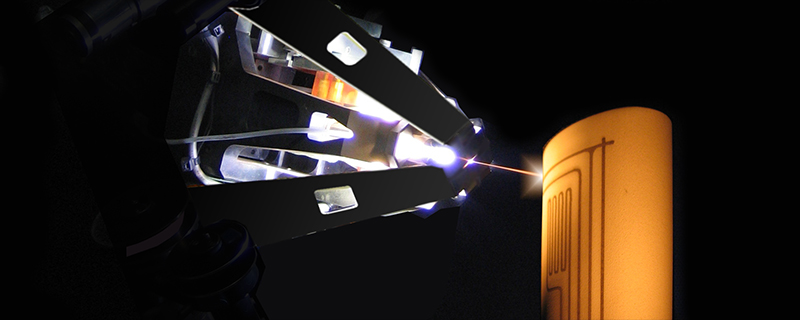CVD MesoScribe Technologies Corporation, a subsidiary of New York’s CVD Equipment Corporation, along with 4 other collaborators has been awarded $4.7 million to develop its electronics 3D printing technology as part of a project led by Pennsylvania State University.
Funding was provided by the U.S. Department of Energy’s (DOE) Advanced Research Projects Agency-Energy (ARPA-E), and the particular field of interest supported by the grant is the integration of printed sensors into 3D printed gas turbine components.

MesoPlasma Direct Write Thermal Spray 3D printing
MesoScribe is the provider of a Direct Write Thermal Spray (DWTS) Technology termed MesoPlasma™, which is capable of 3D printing electronics onto the surface of varied substrates. The company offers this capability as a service to customers (rather than a system) creating printed heaters, conformal antennas, integrated wiring and sensors. Primary markets for MesoPlasma are aerospace, power generation, satellite and defense sectors, with the U.S. government being one of MesoScribe’s primary customers.
“MesoScribe’s printing technology,” explains Jeff Brogan, Director of Sales & Marketing at MesoScribe, “enables new opportunities for 3D printed electronics and harsh environment sensing by printing sensors directly onto conformal surfaces that are robust, and can measure part temperature, strain, and heat flux while operating in extreme environments.”

Smarter, more efficient 3D printed turbines
As a leading partner on the project, Penn State had a fundamental role in securing the grant from ARPA-E, and will be leading the research at its Steady Thermal Aero Research Turbine (START) Laboratory. Other contributors to the project are the Georgia Institute of Technology, United Technologies Research Center, and Siemens Energy, which won a 3D Printing Industry Award for its 3D printed turbine blades in 2017.
By integrating sensors into the structure of 3D printed gas turbine components, the partners aim to decrease the per-part cost and increase their efficiency. Research will be related to the development of advanced temperature and heat flux sensors to support hypersonic flight system testing. It will particularly focus on MesoPlasma application to thermal protection system materials, including ceramic matrix composites (CMCs) which offer high thermal shock resistance.
Professor Karen A. Thole, Director of the START Laboratory and Head of the Mechanical Engineering department at Penn State, outlines, “A major roadblock toward integration of sensors into critical gas turbine components is the ability to adhere sensors that are accurate and reliable.
“With the advancement of metal printing turbine components through additive manufacturing, the challenge of integrating sensors becomes even more important for developing new turbine engines.
“The team we have assembled to address the challenges and opportunities of integrating sensors onto additively manufactured turbine components brings important expertise and are excited to work together to address the challenges.”
For updates on this project and more additive manufacturing related news subscribe to the 3D Printing Industry newsletter, follow us on Twitter and like us on Facebook. Seeking jobs in engineering? Make your profile on 3D Printing Jobs, or advertise to find experts in your area.
Featured image shows the experimental turbine at the Steady Thermal Aero Research Turbine (START) Laboratory, Penn State. Photo via PennState College of Engineering



